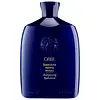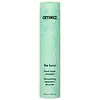What's inside
What's inside
 Key Ingredients
Key Ingredients

No key ingredients
 Benefits
Benefits

 Concerns
Concerns

 Ingredients Side-by-side
Ingredients Side-by-side

Water
Skin ConditioningSodium Cocoyl Isethionate
CleansingSodium Lauroyl Methyl Isethionate
CleansingCocamide Mipa
EmulsifyingDimethicone
EmollientPropanediol
SolventPolyglyceryl-3 Laurate
EmulsifyingSodium Lauroyl Sarcosinate
CleansingPentylene Glycol
Skin ConditioningGlycerin
HumectantAcrylates/Beheneth-25 Methacrylate Copolymer
Parfum
MaskingGlycol Distearate
EmollientSodium Lauroamphoacetate
CleansingAmodimethicone
Sodium PCA
HumectantGuar Hydroxypropyltrimonium Chloride
Skin ConditioningSorbeth-230 Tetraoleate
EmulsifyingDivinyldimethicone/Dimethicone Copolymer
Caprylyl Glycol
EmollientSodium Benzoate
MaskingChlorphenesin
AntimicrobialPolyquaternium-113
Trisodium Ethylenediamine Disuccinate
Ethylhexylglycerin
Skin ConditioningPolyquaternium-7
Sodium Phytate
Quaternium-95
UV AbsorberDecyl Glucoside
CleansingPanthenol
Skin ConditioningVaccinium Macrocarpon Fruit Extract
AstringentSimmondsia Chinensis Seed Oil
EmollientLaureth-23
CleansingLaureth-4
EmulsifyingCetrimonium Chloride
AntimicrobialDimethiconol
EmollientTrideceth-15
EmulsifyingTrideceth-3
EmulsifyingSorbitan Laurate
EmulsifyingHydrolyzed Vegetable Protein
Skin ConditioningLauryl Glucoside
CleansingPhenoxyethanol
PreservativeFumaric Acid
BufferingRosmarinus Officinalis Leaf Extract
AntimicrobialC12-13 Alketh-23
CleansingC12-13 Alketh-3
EmulsifyingSalicylic Acid
MaskingCitrullus Lanatus Seed Oil
EmollientLitchi Chinensis Fruit Extract
Skin ConditioningVaccinium Macrocarpon Seed Oil
Skin ConditioningStearic Acid
CleansingLeontopodium Alpinum Flower/Leaf Extract
Skin ConditioningAcetic Acid
BufferingGlyceryl Caprylate
EmollientSodium Metabisulfite
AntioxidantCitric Acid
BufferingPentaerythrityl Tetra-Di-T-Butyl Hydroxyhydrocinnamate
AntioxidantPotassium Hydroxide
BufferingHexyl Cinnamal
PerfumingLimonene
PerfumingLinalool
PerfumingWater, Sodium Cocoyl Isethionate, Sodium Lauroyl Methyl Isethionate, Cocamide Mipa, Dimethicone, Propanediol, Polyglyceryl-3 Laurate, Sodium Lauroyl Sarcosinate, Pentylene Glycol, Glycerin, Acrylates/Beheneth-25 Methacrylate Copolymer, Parfum, Glycol Distearate, Sodium Lauroamphoacetate, Amodimethicone, Sodium PCA, Guar Hydroxypropyltrimonium Chloride, Sorbeth-230 Tetraoleate, Divinyldimethicone/Dimethicone Copolymer, Caprylyl Glycol, Sodium Benzoate, Chlorphenesin, Polyquaternium-113, Trisodium Ethylenediamine Disuccinate, Ethylhexylglycerin, Polyquaternium-7, Sodium Phytate, Quaternium-95, Decyl Glucoside, Panthenol, Vaccinium Macrocarpon Fruit Extract, Simmondsia Chinensis Seed Oil, Laureth-23, Laureth-4, Cetrimonium Chloride, Dimethiconol, Trideceth-15, Trideceth-3, Sorbitan Laurate, Hydrolyzed Vegetable Protein, Lauryl Glucoside, Phenoxyethanol, Fumaric Acid, Rosmarinus Officinalis Leaf Extract, C12-13 Alketh-23, C12-13 Alketh-3, Salicylic Acid, Citrullus Lanatus Seed Oil, Litchi Chinensis Fruit Extract, Vaccinium Macrocarpon Seed Oil, Stearic Acid, Leontopodium Alpinum Flower/Leaf Extract, Acetic Acid, Glyceryl Caprylate, Sodium Metabisulfite, Citric Acid, Pentaerythrityl Tetra-Di-T-Butyl Hydroxyhydrocinnamate, Potassium Hydroxide, Hexyl Cinnamal, Limonene, Linalool
Water
Skin ConditioningSodium C14-16 Olefin Sulfonate
CleansingCocamidopropyl Betaine
CleansingGlycerin
HumectantDisodium Cocoamphodiacetate
CleansingPEG-7 Glyceryl Cocoate
EmulsifyingHippophae Rhamnoides Fruit/Seed Oil
AntimicrobialBorago Officinalis Seed Oil
EmollientPersea Gratissima Oil
Skin ConditioningMangifera Indica Seed Butter
Skin ConditioningButyrospermum Parkii Butter
Skin ConditioningHydroxypropyl Guar Hydroxypropyltrimonium Chloride
Lavandula Angustifolia Flower Extract
CleansingChamomilla Recutita Flower Extract
MaskingRosmarinus Officinalis Leaf Extract
AntimicrobialHydrolyzed Quinoa
Skin ConditioningAminomethyl Propanol
BufferingBis-PCA Dimethicone
Butylene Glycol
HumectantSodium Gluconate
Skin ConditioningDisodium PEG-12 Dimethicone Sulfosuccinate
CleansingPEG-12 Dimethicone
Skin ConditioningPEG-150 Distearate
EmulsifyingPolyquaternium-10
Polyquaternium-7
Polysorbate 20
EmulsifyingPropylene Glycol
HumectantGlycol
HumectantGlycol Stearate
EmollientGlycol Distearate
EmollientSodium Methyl Cocoyl Taurate
CleansingCitric Acid
BufferingDehydroacetic Acid
PreservativeBenzyl Alcohol
PerfumingPhenoxyethanol
PreservativePotassium Sorbate
PreservativeSodium Benzoate
MaskingBenzoic Acid
MaskingParfum
MaskingWater, Sodium C14-16 Olefin Sulfonate, Cocamidopropyl Betaine, Glycerin, Disodium Cocoamphodiacetate, PEG-7 Glyceryl Cocoate, Hippophae Rhamnoides Fruit/Seed Oil, Borago Officinalis Seed Oil, Persea Gratissima Oil, Mangifera Indica Seed Butter, Butyrospermum Parkii Butter, Hydroxypropyl Guar Hydroxypropyltrimonium Chloride, Lavandula Angustifolia Flower Extract, Chamomilla Recutita Flower Extract, Rosmarinus Officinalis Leaf Extract, Hydrolyzed Quinoa, Aminomethyl Propanol, Bis-PCA Dimethicone, Butylene Glycol, Sodium Gluconate, Disodium PEG-12 Dimethicone Sulfosuccinate, PEG-12 Dimethicone, PEG-150 Distearate, Polyquaternium-10, Polyquaternium-7, Polysorbate 20, Propylene Glycol, Glycol, Glycol Stearate, Glycol Distearate, Sodium Methyl Cocoyl Taurate, Citric Acid, Dehydroacetic Acid, Benzyl Alcohol, Phenoxyethanol, Potassium Sorbate, Sodium Benzoate, Benzoic Acid, Parfum
 Reviews
Reviews

Ingredients Explained
These ingredients are found in both products.
Ingredients higher up in an ingredient list are typically present in a larger amount.
Citric Acid is an alpha hydroxy acid (AHA) naturally found in citrus fruits like oranges, lemons, and limes.
Like other AHAs, citric acid can exfoliate skin by breaking down the bonds that hold dead skin cells together. This helps reveal smoother and brighter skin underneath.
However, this exfoliating effect only happens at high concentrations (20%) which can be hard to find in cosmetic products.
Due to this, citric acid is usually included in small amounts as a pH adjuster. This helps keep products slightly more acidic and compatible with skin's natural pH.
In skincare formulas, citric acid can:
While it can provide some skin benefits, research shows lactic acid and glycolic acid are generally more effective and less irritating exfoliants.
Most citric acid used in skincare today is made by fermenting sugars (usually from molasses). This synthetic version is identical to the natural citrus form but easier to stabilize and use in formulations.
Read more about some other popular AHA's here:
Learn more about Citric AcidGlycerin is already naturally found in your skin. It helps moisturize and protect your skin.
A study from 2016 found glycerin to be more effective as a humectant than AHAs and hyaluronic acid.
As a humectant, it helps the skin stay hydrated by pulling moisture to your skin. The low molecular weight of glycerin allows it to pull moisture into the deeper layers of your skin.
Hydrated skin improves your skin barrier; Your skin barrier helps protect against irritants and bacteria.
Glycerin has also been found to have antimicrobial and antiviral properties. Due to these properties, glycerin is often used in wound and burn treatments.
In cosmetics, glycerin is usually derived from plants such as soybean or palm. However, it can also be sourced from animals, such as tallow or animal fat.
This ingredient is organic, colorless, odorless, and non-toxic.
Glycerin is the name for this ingredient in American English. British English uses Glycerol/Glycerine.
Learn more about GlycerinGlycol Distearate serves as a pearlizing or opacifying agent in cosmetic products.
It's often included in cleansers and haircare products to give them a lustrous or shimmering appearance.
It is derived from stearic acid, a natural fatty acid commonly found in vegetable oils and animal fats.
Glycol Distearate isn't fungal acne safe.
Learn more about Glycol DistearateParfum is a catch-all term for an ingredient or more that is used to give a scent to products.
Also called "fragrance", this ingredient can be a blend of hundreds of chemicals or plant oils. This means every product with "fragrance" or "parfum" in the ingredients list is a different mixture.
For instance, Habanolide is a proprietary trade name for a specific aroma chemical. When used as a fragrance ingredient in cosmetics, most aroma chemicals fall under the broad labeling category of “FRAGRANCE” or “PARFUM” according to EU and US regulations.
The term 'parfum' or 'fragrance' is not regulated in many countries. In many cases, it is up to the brand to define this term.
For instance, many brands choose to label themselves as "fragrance-free" because they are not using synthetic fragrances. However, their products may still contain ingredients such as essential oils that are considered a fragrance by INCI standards.
One example is Calendula flower extract. Calendula is an essential oil that still imparts a scent or 'fragrance'.
Depending on the blend, the ingredients in the mixture can cause allergies and sensitivities on the skin. Some ingredients that are known EU allergens include linalool and citronellol.
Parfum can also be used to mask or cover an unpleasant scent.
The bottom line is: not all fragrances/parfum/ingredients are created equally. If you are worried about fragrances, we recommend taking a closer look at an ingredient. And of course, we always recommend speaking with a professional.
Learn more about ParfumPhenoxyethanol is a preservative that has germicide, antimicrobial, and aromatic properties. Studies show that phenoxyethanol can prevent microbial growth. By itself, it has a scent that is similar to that of a rose.
It's often used in formulations along with Caprylyl Glycol to preserve the shelf life of products.
Polyquaternium-7 is a light to clear colored liquid. It is commonly found in haircare products for its film-forming and anti-static properties.
According to a manufacturer, it is a non-paraben and specially developed for negatively charged surfactant systems. This makes it a great hairstyle holder and helps to improve wet hair detangling without adding buildup.
Rosmarinus Officinalis Leaf Extract comes from rosemary. Rosemary is native to the Mediterranean.
While Rosmarinus Officinalis Leaf Oil can be volatile due to its fragrant properties, the fragrance components are usually removed in the leaf extract.
Rosemary Leaf Extract contains many antioxidants such as rosmarinic acid and caffeic acid. Rosemarinic acid, a compound found in rosemary leaf, has been found to help soothe skin conditions such as eczema and acne.
Learn more about Rosmarinus Officinalis Leaf ExtractSodium Benzoate is a preservative. It's used in both cosmetic and food products to inhibit the growth of mold and bacteria. It is typically produced synthetically.
Both the US FDA and EU Health Committee have approved the use of sodium benzoate. In the US, levels of 0.1% (of the total product) are allowed.
Sodium benzoate works as a preservative by inhibiting the growth of bacteria inside of cells. It prevents the cell from fermenting a type of sugar using an enzyme called phosphofructokinase.
It is the salt of benzoic acid. Foods containing sodium benzoate include soda, salad dressings, condiments, fruit juices, wines, and snack foods.
Studies for using ascorbic acid and sodium benzoate in cosmetics are lacking, especially in skincare routines with multiple steps.
We always recommend speaking with a professional, such as a dermatologist, if you have any concerns.
Learn more about Sodium BenzoateWater. It's the most common cosmetic ingredient of all. You'll usually see it at the top of ingredient lists, meaning that it makes up the largest part of the product.
So why is it so popular? Water most often acts as a solvent - this means that it helps dissolve other ingredients into the formulation.
You'll also recognize water as that liquid we all need to stay alive. If you see this, drink a glass of water. Stay hydrated!
Learn more about Water